Kinnewry House
Houses within 15km of this house
Displaying 37 houses.
Houses within 15km of Kinnewry House
Displaying 37 houses.
| House name | Description | |
|---|---|---|
| Moore Hall | Built in 1795 and burnt down in 1923. The residence of George Henry Moore, MP, at the time of Griffith's Valuation, when it was valued at £45. Slater refers to it as the seat of George A. Moore in 1894. The ruin is now owned by Coillte Teoranta. |

|
| Greenhills | Greenhills was part of the estate of the Marquess of Sligo until the sale to William Livingstone in 1854 and was let to Joseph Bourke in the early 19th century. It was later occupied by Archibald Stavert who held it from William Livingstone at the time of Griffith's Valuation. It was owned by Matt Fahy in the late 1990s and is still extant. |
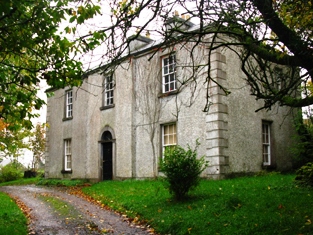
|
| Creagh | The original house was situated beside the River Robe and was described in September 1836 by Robert Graham as a "nicely laid out cottage residence". Earlier, in 1786, Wilson refers to it as the seat of Mr. Cuff. Mary Louisa Cuffe was leasing the property from Colonel Charles Knox at the time of Griffiths Valuation, when it was valued at £32. A new house was built by Colonel Charles Knox in 1875, which became a tuberculosis sanatorium and a centre for the Agricultural Institute in the 20th century. James Cuff (recorded as Duff), of Creagh, near Ballinrobe, is mentioned as the proprietor of townlands in the parish of Ballynacourty, barony of Dunkellin, county Galway, at the time of the first Ordnance Survey in the 1830s. |

|
| Castlecarra | Granted to Sir Henry Lynch after the Restoration, it was the family's main home in county Mayo for much of the 18th century. In 1786 Wilson refers to Castle Carra as the seat of Mr. Lynch. The mansion house and offices at Castlecarra were described in 1844 by Samuel Nicholson as "now almost ruins". Castlecarra was leased to the Brownes of Castlecarra at this time and was part of their property for sale in 1852. The ruins of the original tower house are still extant but much of the surroundings are now covered by forestry. | |
| Mount Pleasant | Home of George Mahon in 1814 and of Charles G. Mahon in the 1850s when the house was valued at over £22. It is no longer extant. | |
| Westport House | Built on the site of the O'Malley castle of Cathair na Mart by Colonel John Browne, expanded by his grandson to the design of Richard Cassels, the house has remained in the possession of the Browne family for over three centuries. They still live there and the house and its grounds function as a major tourist attraction. |

|
| Mount Browne | A house built in the early 18th century and used by the first generations of Brownes at Westport. Wilson describes it as the seat of Mr. Browne in 1786. It was later occupied by Denis Browne, Member of Parliament, brother of the 1st Marquess of Sligo, and other family members. It was leased by John D. Browne from the Marquess of Sligo's estate at the time of Griffith's Valuation, when it was valued at £30. The Irish Tourist Association file of the 1940s states that the mansion had been demolished. | |
| Cherry Cottage | A house inhabited mainly by agents to the Marquess of Sligo, including George Hildebrand in the mid nineteenth century and George Taylor in the early 20th century. At the time of Griffith's Valuation it was valued at £15. The Hastings interest in this house was sold in the Landed Estates' Court in November 1874. It is still extant. |

|
| Summerville/Villa Lodge | A house orginally built for a member of the Browne family, it was leased by the 2nd Marquess of Sligo to Courtney Kenny of Ballinrobe in 1830 and was used by the Kennys as a summer residence. Courtney Kenny leased the property to John Sidney Smith, agent to the Westport estate in 1855. The house was valued at £14 at this time. A drawing, map and 20th century accounts re this property are included in the Kenny Papers. |
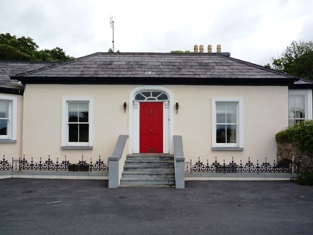
|
| Prospect House | Home of the Buchanan family in the latter part of the 19th century. Slater refers to it as the seat of Col. Henry J. Buchanan in 1894. Still extant and very well maintained. |

|
| Trafalgar Lodge | Described in the sale advertisement of 1866 as a commodious dwelling in the cottage style on the seashore, containing 'good parlour, four bedrooms, with coach house, stabling, piggery and other useful offices, the entire forming a square and enclosing a spacious yard'. The occupant was James Louden and the house had formerly been the residence of Captain Butcher of the Mayo Rifles. In 1874 the interest of Bridget Hastings in Trafalgar Lodge was advertised for sale in the Landed Estates' Court. | |
| Altamont Villa | A Browne house described in the 1830s as a slated house with 2 stories at the rear. Also known as Mallow Cottage and possibly New Brighton Lodge, it was leased by the 2nd Marquess of Sligo to Neal Davis in the late 1830s. Sold to William O'Brien, whose widow left it to the Convent of Mercy. | |
| Knockranny | A house in the town of Westport occupied by the Livingstones. It was valued at £40 at the time of Griffith's Valuation which included the house, offices, gate lodge and another lodge. This may have been the house marked on the first Ordnance Survey map as Westport Lodge. This building now forms part of the Sacred Heart School complex. |
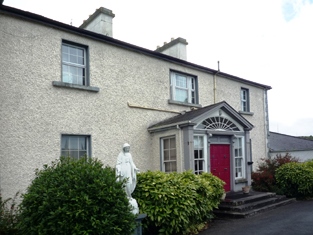
|
| Carnacon House | Home of the McDonnell family in the early 19th century and probably earlier as local sources suggest General James McDonnell, who fought in the 1798 Rebellion, was born there. In 1844 described by Samuel Nicholson as "neat and comfortable, prettily situated upon the lake and ornamented by thriving plantations". It was purchased by the Hughes family in the 1940s and is still in their possession. |
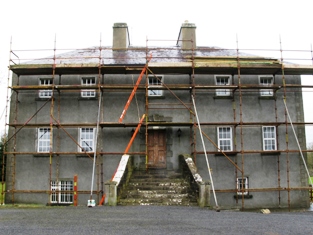
|
| Castlelucas | A house belonging to the Blakes of Ballinafad, let to Lieutenant Hugh Ryan in 1814 and to Mrs Phibbs in the 1830s who subleased to George Ormsby of the Ballinamore family. At the time of Griffith's Valuation, it was leased by Matthew Phibbs from Mark Blake and valued at £5. It is no longer extant. | |
| Clogher | According to Bence Jones this house was built circa 1798 though Wilson refers to a house at Clogher as the seat of Patrick Lynch in 1786. In 1844 Samuel Nicholson described Clogher House as "amongst the largest and the best in the Country, and appears to be kept in excellent order". Patrick C. Lynch was leasing it from Sir Robert H. Blosse at the time of Griffith's Valuation, when it was valued at £40. It was in the ownership of the Fitzgerald Kenney family at the beginning of the 20th century and is now a ruin. |

|
| Errew | An unoccupied house and offices valued at £11 were held by James Hardiman at the time of Griffith's Valuation. A school and monastery are shown on the 25-inch Ordnance Survey map of this area in the 1890s. These buildings are still extant. | |
| Fortlawn Cottage | William Mulrooney held this property in fee at the time of Griffith's Valuation when it was valued at £5. It is labelled as Fortlawn Cottage on both the 1st and 25-inch edition Ordnance Survey maps. A house is still extant at the site. | |
| Hazelrock Lodge | Valued at £5 at the time of Griffith's Valuation and held by the Honourable George Frederick Yelverton from Viscount Avonmore. The National Inventory of Architectural Heritage contends that it was built in the early nineteenth century for Barry John Yelverton, third Viscount Avonmore. It is now a ruin. |

|
| Kilboyne | Described at the time of the first Ordnance Survey as a 'good house surrounded by a neat but small demesne'. At the time of Griffith's Valuation it was held in fee by Sir Samuel O'Malley and valued at £12. A modern house exists at the site now. | |
| Kinturk | A residence of the Bourke family in the early 19th century, situated beside Kinturk Castle. In 1786 Wilson refers to it as the seat of Mr. Burke. The townland was in the possession of Rev. H.N. Ormsby at the time of Griffith's Valuation. | |
| Partry House | Bence-Jones describes the house, situated on the shore of Lough Carra, as Georgian with a Wyatt window above the porch. It is likely that it incorporates an earlier house built in the latter part of the 17th century. In 1786 Wilson mentions "Cloonlagheen" as the seat of Mr. Lynch. It was the seat of the Lynch/Blosse Lynch family for three centuries. At the time of Griffith's Valuation, it was held in fee by Henry Lynch Blosse and valued at £14. Owned briefly by David Shaw Smith in the 1990s, now the home of Lorraine O'Donoghue. |

|
| Pheasant Hill | A Sheridan home from the late 18th century to the late 19th century. Wilson, writing in 1786, refers to "Dan" as the seat of Mr. Sheridan. By the time of Griffith's Valuation it was held by John Sheridan from the Earl of Lucan's estate with a valuation of £3. It is not shown on the 25-inch map of the 1890s and modern buildings exist in the area now. | |
| Portroyal | In 1786 Wilson refers to Port Royal as the seat of Mr. Gildea. At the time of Griffith's Valuation, the townland was in the possession of James and Anthony Knox Gildea and the house was valued at £2 10s. The house is not shown on the 25-inch Ordnance Survey map of the 1890s. | |
| Raheens | A house south west of Castlebar, noted by Wilson as the seat of A.N. Browne in 1786. Held by the Browne family from their relatives the Lords Kilmaine. At the time of Griffith's Valuation, it was occupied by Henry Browne and valued at over £16. It is now a ruin. |
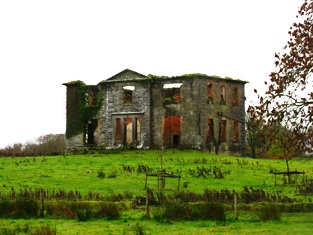
|
| Thomastown | Thomastown was originally leased by Christopher Bowen to Francis Lambert in 1777. It was the residence of Thomas Valentine Clendining in the first half of the 19th century. The unoccupied house was held by Charles G. Mahon at the time of Griffith's Valuation when it was valued at £30. Some buildings survive at the site. | |
| Toormakeady Lodge | Robert Graham in 1836 refers to "Mr Plunket's cottage residence" while in 1837 Lewis describes it as a summer lodge of Dean Plunkets. Sold in 1876 to the Mitchell family of Bradford. Restored in the 1960s and used as a guest house. |

|
| Towerhill | A late 18th century house, occupied by the Blakes until the mid 20th century, now a ruin. 1n 1894 Slater refers to it as the seat of Colonel Maurice Blake. It was valued at £60 at the time of Griffith's Valuation, when it was occupied by Valentine O'Conor Blake. |
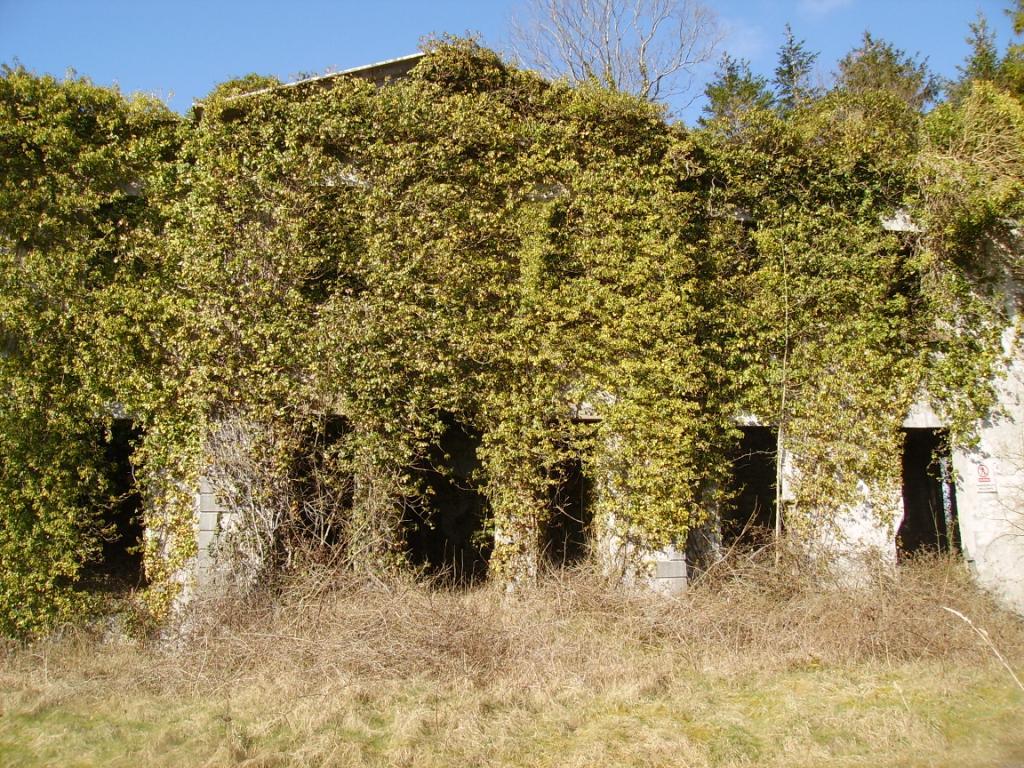
|
| Mount Gordon | An 18th century house, occupied in the 1770s by 'Garden' [Gardiner]. Wilson refers to it as the seat of Mr. Garden [Gardiner] in 1786. It was occupied by Mary Boyd at the time of Griffith's Valuation, when the house was valued at £43. It is still extant and occupied. |

|
| Cloonee | A house built circa 1760, sometimes known as Lakeview. It was occupied in the late 1770s by a member of the Browne family and from the early 19th century by the Blakes. Thomas Walsh was the occupier at the time of Griffith's Valuation. He held the property from Colonel Charles Knox. Cloonee was the home of William Creagh Burke in the early 20th century. The "Connaught Telegraph" of 9 March 1935 reported the sudden death of William C. Burke of Lakeview in the Main Street of Ballinrobe when a fair was taking place. The property passed by marriage to the Ruttledge family of Bloomfield. see www.clooneehouse.com/ |

|
| Cuslough | Lewis describes this house as formerly a 'seat of Lord Tyrawley and now of R.Livesay'. At the time of Griffith's Valuation it was occupied by Richard Livesay, leasing from Colonel Charles Knox, when the house was valued at £12. It stood close to the ruins of Cuslough Castle. | |
| Curramore House | Bence Jones dates this house as circa 1830. At the time of Griffith's Valuation it was occupied by Geoffrey Martyn and valued at £20. It was still in the possession of the Martyn family in the mid 1920s. Curramore is still extant and occupied. |
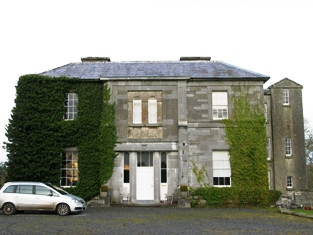
|
| Brownstown | In 1786 Wilson refers to Brownstown as the seat of Mr. Browne. This house is shown on the 1st edition Ordnance Survey map but marked 'in ruins' on the later 25-inch edition. The townland was in the possession of George Browne at the time of Griffith's Valuation. The Irish Tourist Association file describes the house as a 3-storey T shaped plain residence, uninhabited for about 60 years. |

|
| Drimbawn | Built by Catherine Plunket and now owned by the Wilson family. At the time of Griffith's Valuation it was occupied by Catherine Plunkett leasing from the Lynch Blosse estate when the house was valued at almost £5. |

|
| Belclare | At the time of Griffith's Valuation all of Belclare townland was held by James Pinkerton and John Thompson who had a large milling business there, as well as three houses valued at £26, £13 and £18. The Livingstones must have bought out Pinkerton and Thompson. Belclare Lodge is marked on the OS map of 183. The Livingstone's house is shown on the 25-inch map of the 1890s, labelled Shivdella House, which is still extant. Buildings were demolished at Belclare in the late 20th century to make room for building development. |

|
| Castleburke | A home of the Bourke family and their descendants. Occupied by Patrick Horan in 1814 and from 1821 James Tuohy was the tenant. The castle was in ruins by the time of the first Ordnance Survey circa 1838. It is now owned by Eamonn de Burca. | |
| Drumminroe | Malachy Tuohy held a house valued at £8 from George Henry Moore at the time of Griffith's Valuation. Members of the Tuohy family still occupy this house. |

